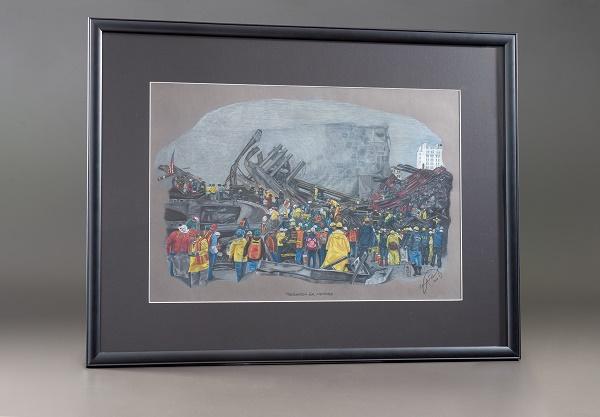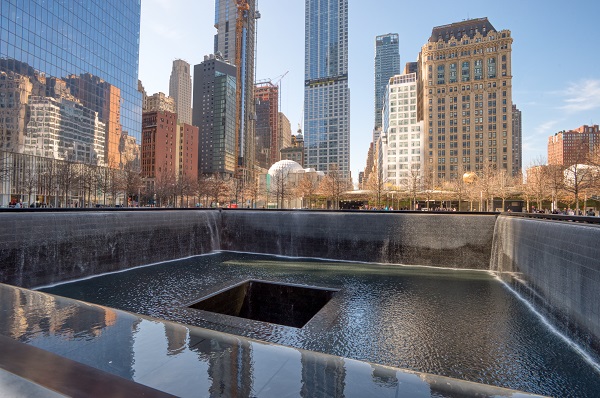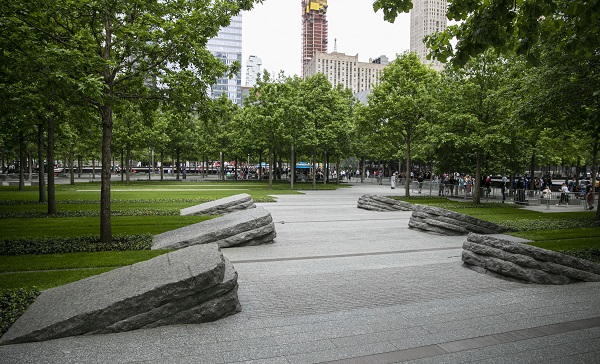Make a donation to the museum
First Responder Turns to Art to Share His Experience at Ground Zero
First Responder Turns to Art to Share His Experience at Ground Zero

First responder Mitchel Rosen worked for the Port Authority Police Department (PAPD) from 1980 until his retirement in 2006. During his career with the PAPD, he covered a variety of postings, including service at the Holland Tunnel, the Port Authority Bus Terminal, the PATH train and John F. Kennedy International Airport. For much of the 1990s, Rosen was assigned to the World Trade Center command. There, he gained deep familiarity with its 16-acre, seven-building campus, best defined by the soaring Twin Towers.
By September 2001, Rosen had shifted to a highway patrol assignment at the George Washington Bridge. During rush hour into the city on the morning of Sept. 11, he was surprised to see a low-flying plane passing overhead, heading south down the Hudson River—traditionally, a no-fly zone for commercial aircraft. Shortly thereafter, traffic on the bridge braked to a stand-still as car radios received the late-breaking news of a plane accident at the World Trade Center. Seconds later, Rosen received a radio report confirming the story. With coworker Bruce A. Reynolds, the two PAPD officers drove in separate cars toward lower Manhattan. They parted ways upon arrival at the scene following the collapse of the South Tower. Officer Reynolds was among the 37 uniformed responders from the Port Authority Police Department killed in the line of duty that day.
Rosen survived, and would spend the next three to four weeks participating in the urgent rescue and recovery efforts at Ground Zero. In an oral history recorded with 9/11 Memorial Museum staff several years ago, he recalled looking for survivors while working the bucket brigade before heavy machinery was set up at the site. The heat emanating from the immense wreckage pile was intense enough to melt the rubber soles of his boots. Working in small teams of three supervised by a senior PAPD officer, Rosen and his colleagues spread themselves around the site to assist other agencies by sharing their locational familiarity with the WTC, the layout of which was otherwise incomprehensible due to the scale and physics of destruction. Communications were conducted mostly in silence; "everyone just understood what needed to be done," he said.
After retiring from the department in 2006, Rosen finally had time to dedicate to a favorite hobby: creating highly realistic drawings which also demonstrated his police officer's attentiveness to details. A self-taught artist, Rosen prefers to use colored pencils as a medium as he works to capture precise moments in time that will generate an emotional recognition and engagement with the viewer. His body of recent art is comprised mostly of carefully observed New York City streetscapes, many of which he had traveled during his 26 years with the PAPD. In the wake of 9/11, he also drew a portrait in tribute to Bruce Reynolds, which was displayed in the lobby of the police agency’s administrative building.
In 2017, Rosen began to plan a new drawing, eventually titled "Search for Heroes." After revisiting a collection of personal photos taken during his time at Ground Zero, he was struck anew by the impact of one taken on September 12 that depicted responders from multiple agencies toiling on the bucket brigade. He studied it carefully by enlarging the digitized image on his computer. Inspiration took hold as he began to sketch the scene with a #2 pencil. A left-hander, he worked systematically from right to left, and top to bottom, aided by a magnifying glass to ensure that as much detail as possible would be translated into the composition. He used Canson ® paper, made to showcase the chromatic range and layering capabilities of colored pencils. In total, more than 100 hours were consumed in executing the drawing. Once completed, Rosen used a sealant spray to fix the colors.
During a meeting with the Museum staff, Rosen explained that he had never intended to use his Ground Zero photographs as a source for artistic response. However, after visiting the 9/11 Memorial Museum, he felt that something commemorative might emerge by drawing what he had seen and experienced in 2001. Thus, he returned to the photographs he had taken during breaks on site.
The September 12 image he chose for this experiment unlocked vivid memories of the commingled hope, heartbreak, exhaustion and determination that characterized those earliest hours of bucket-brigade operations. Summative of the collective efforts he witnessed at the just-demolished WTC, "Search for Heroes" also underscores the objective driving that exceptional commitment: to find and recover those trained, determined emergency workers who had raced to help and were missing or feared dead. In 2018, the artist contributed the painting to the collection of the 9/11 Memorial Museum.
More than 17 years after he joined fellow PAPD responders at the disaster site in lower Manhattan, Rosen has been treated for breathing and asthma issues tied to his service at Ground Zero.
By Jan Seidler Ramirez, Executive Vice President of Collections & Chief Curator, 9/11 Memorial Museum
Previous Post
Reflecting on 2018: See the 9/11 Memorial & Museum’s Year in Review

The 9/11 Memorial & Museum is pleased to share the 2018 Year in Review, which offers a look back at 12 months of innovative programming and commemoration.
Next Post
The 9/11 Memorial Glade Officially Dedicated

The 9/11 Memorial & Museum dedicated the Memorial Glade on the 17th anniversary of the official end of the recovery mission at Ground Zero.